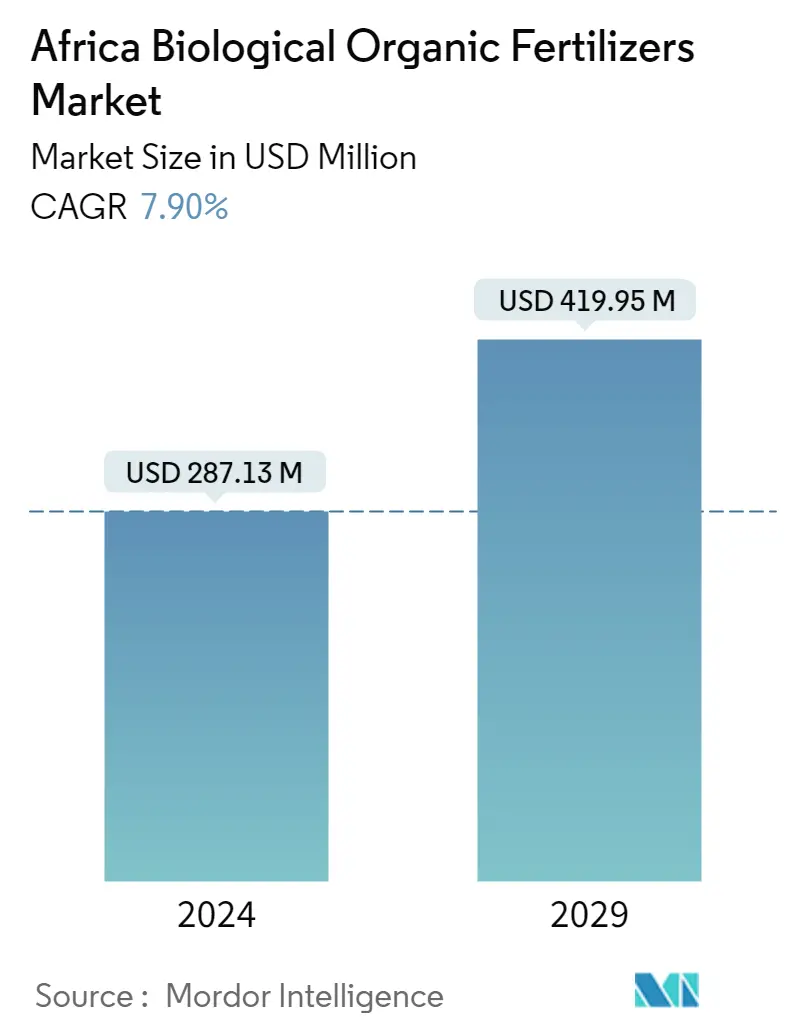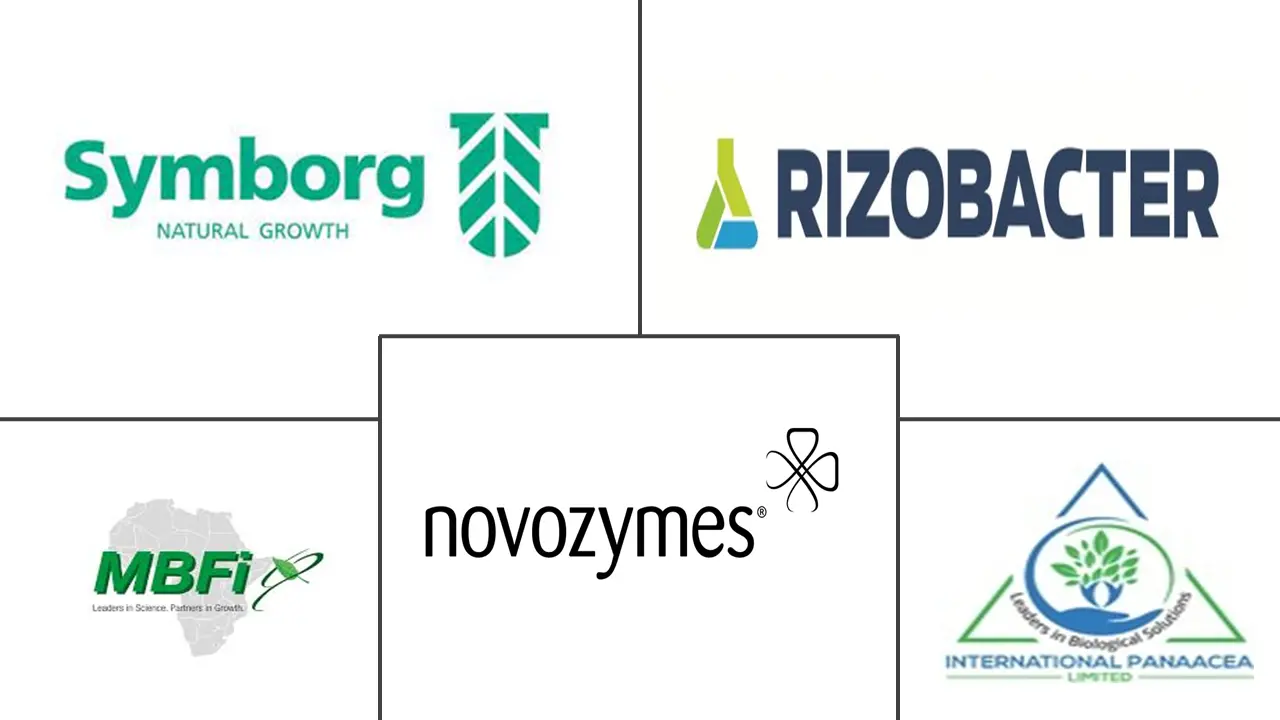Market Size of Africa Biological Organic Fertilizers Industry

| Study Period | 2019 - 2029 |
| Base Year For Estimation | 2023 |
| Forecast Data Period | 2024 - 2029 |
| Market Size (2024) | USD 287.13 Million |
| Market Size (2029) | USD 419.95 Million |
| CAGR (2024 - 2029) | 7.90 % |
| Market Concentration | Low |
Major Players
*Disclaimer: Major Players sorted in no particular order |
Africa Organic Fertilizers Market Analysis
The Africa Biological Organic Fertilizers Market size is estimated at USD 287.13 million in 2024, and is expected to reach USD 419.95 million by 2029, growing at a CAGR of 7.90% during the forecast period (2024-2029).
- Organic agriculture promotes food systems that increase food security and improve living conditions but currently, only 0.2 percent of agricultural land in Africa is dedicated to organic farming. This was due to limited knowledge of how organic products are produced, processed, and marketed. However, the war in Ukraine has caused a significant disruption in global supply chains, particularly for energy, food, and fertilizers. The effect of the conflict on global fertilizer prices has been especially pronounced in Africa. This brief looks at the immediate effects of the Ukraine war on local fertilizer prices and its likely impact on food production.
- Even before the outbreak of war in Ukraine, fertilizers prices across Africa were higher compared to other regions of the world. Due to this reason, farmers are shifting to organic fertilizers, and the area of organic farmland in Africa has doubled in the last decade to 2.1 million hectares. According to FiBL, the most prominent organic centers are in North and East Africa. In Kenya, nuts and coconuts dominate organic output. In Tunisia, it is olives. Ethiopia and Tanzania are big coffee growers, while Uganda is home to the most organic producers in Africa, the crop of choice is cacao.
- According to data from the Research Institute of Organic Agriculture (FiBL), in a continent where natural agricultural and subsistence farming are widely practiced. Farmers who avoid synthetic fertilizers and pesticides but are unable to get organic certificates to say high costs, corruption, and little government support stymie their plans to export abroad.
- The focus on organic cultivation and the need for sustainable farming practices are the major reasons for Africa's increasing consumption of organic fertilizers. Various government subsidies and initiatives in developing countries for sustainable organic farming are expected to maintain continuous growth in the market. More awareness among the farmers is needed to maintain the growth of the market. The developing and untapped markets in Africa would provide substantial growth opportunities.
Africa Organic Fertilizers Industry Segmentation
Organic fertilizers are derived from many animal and plant-based residues and mineral ores, and they are also developed from beneficial microorganisms.
The Africa organic fertilizers market is segmented by type (microorganism and organic residues), application (cereals, legumes, fruits and vegetables, plantations, and other applications), and geography (South Africa, Egypt, Ethiopia, and the Rest of Africa).
The report offers market size and forecast in terms of value in USD million for the above-mentioned segments.
| Product Type | |
| Microorganisms | |
| Organic Residues |
| Application type | |
| Grains and Cereals | |
| Pulses and Oilseeds | |
| Fruits and Vegetables | |
| Commercial crops | |
| Other Crop Types |
| Geography | |
| South Africa | |
| Ethiopia | |
| Egypt | |
| Rest of Africa |
Africa Biological Organic Fertilizers Market Size Summary
The organic fertilizer market in Africa is experiencing significant growth, driven by the increasing shift towards sustainable farming practices and the need for cost-effective alternatives to synthetic fertilizers. The disruption in global supply chains due to geopolitical events, such as the war in Ukraine, has further accelerated this shift, as rising fertilizer prices have prompted farmers to explore organic options. Despite the challenges of limited knowledge and certification issues, the area under organic farming in Africa has seen substantial expansion, particularly in regions like North and East Africa, where crops such as nuts, olives, coffee, and cocoa are prominently cultivated. The continent's vast arable land and growing population present a unique opportunity for the organic fertilizer market to thrive, supported by government initiatives and subsidies aimed at promoting sustainable agriculture.
South Africa stands out as a leading market for organic fertilizers in Africa, driven by environmental concerns and the need to address soil degradation caused by excessive use of chemical fertilizers. The country's increasing organic land area and the presence of regional and global players in the biofertilizer sector contribute to the market's growth. Companies like Rizobacter Argentina S.A., Novozymes A/S, and Symborg are actively expanding their product offerings and collaborating with government organizations to enhance their market presence. These efforts, coupled with innovations in organic fertilizer products, are expected to sustain the market's growth trajectory in the coming years, as Africa continues to embrace organic farming as a viable solution to its agricultural challenges.
Africa Biological Organic Fertilizers Market Size - Table of Contents
-
1. MARKET DYNAMICS
-
1.1 Market Overview
-
1.2 Market Drivers
-
1.3 Market Restraints
-
1.4 Porter's Five Forces Analysis
-
1.4.1 Threat of New Entrants
-
1.4.2 Bargaining Power of Consumers
-
1.4.3 Bargaining Power of Suppliers
-
1.4.4 Threat of Substitute Products
-
1.4.5 Intensity of Competitive Rivalry
-
-
-
2. MARKET SEGMENTATION
-
2.1 Product Type
-
2.1.1 Microorganisms
-
2.1.2 Organic Residues
-
-
2.2 Application type
-
2.2.1 Grains and Cereals
-
2.2.2 Pulses and Oilseeds
-
2.2.3 Fruits and Vegetables
-
2.2.4 Commercial crops
-
2.2.5 Other Crop Types
-
-
2.3 Geography
-
2.3.1 South Africa
-
2.3.2 Ethiopia
-
2.3.3 Egypt
-
2.3.4 Rest of Africa
-
-
Africa Biological Organic Fertilizers Market Size FAQs
How big is the Africa Biological Organic Fertilizers Market?
The Africa Biological Organic Fertilizers Market size is expected to reach USD 287.13 million in 2024 and grow at a CAGR of 7.90% to reach USD 419.95 million by 2029.
What is the current Africa Biological Organic Fertilizers Market size?
In 2024, the Africa Biological Organic Fertilizers Market size is expected to reach USD 287.13 million.

